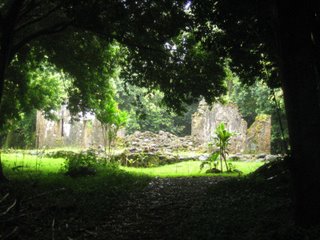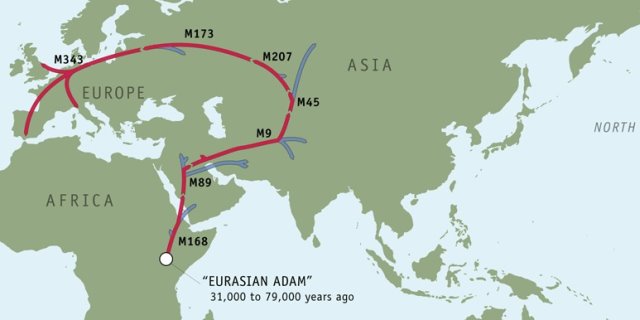 A group of us headed to the ruins of Kani- akapupu in Nu`uanu this past Saturday. There's a trail to the area, but it's not marked, and Kani- akapupu isn't on most maps. The idea is to keep the tourists out. I only learned of it while digging through some old TMK maps while working on another project.
A group of us headed to the ruins of Kani- akapupu in Nu`uanu this past Saturday. There's a trail to the area, but it's not marked, and Kani- akapupu isn't on most maps. The idea is to keep the tourists out. I only learned of it while digging through some old TMK maps while working on another project.I got most of my information from the Pacific Worlds Nu`uanu Page. The site was once a heiau to Lono, where priests would collect tithes from travellers coming to and from the windward side. Pai`ea [Kamehameha I] and his army rested here during the conquest of O`ahu.
Later, Kamehameha III built his summer residence here. Kamehameha IV received his traditional education here. And in 1847 it was the site of a major feast celebrating the fourth anniversary of the restoration of the monarchy. From the website:
Hawaiians began to go up the valley in large numbers at early dawn. At 10 o'clock the royal party left the palace for Nu‘uanu valley in the state carriage, followed by the military (both infantry and officers on horseback bearing standards), and one thousand horse-women, five abreast, "wearing palm leaf hats and Spanish ponchos, gay with ribbons and floral wreaths." These were followed by 2,500 horsemen. Men stationed at various locations to count the procession recorded 4,000 horses going up and 4,600 returning--visitors from across the Pali making the difference. (Hawaiian Annual, 1930)
"In a suit of dark broadcloth he stood in an open square or field, a brilliant yellow feather cape over his shoulders and in his hand a beautifully polished spear. Alone, erect, nearly six feet in height, bull chested and muscular, he presented a splendid figure. Opposite him on the mauka or inland side, stood a group of expert spear men wearing yellow feather tippets and armed with spears tipped with a kind of soft, bushing material. At the signal the weapons began to fly at the human target. ‘I‘i at first parried with his single lance, but presently, as the shots became faster, seizing a passing spear aimed at him and parried with both weapons until the play ended amid the prolonged cheers of a great crowd ...." (Reverend HH Parker, 1937)
It was later abandoned, and the 1874 maps already marked it as ruins. Today you can see the ruins of the house and kitchen walls. You can see remnants of the heiau grounds scattered through the woods and bamboo forest. What happened next is a mystery. The entire area, known as Laukaha, was Crown Lands. Yet around the turn of the century much of it was in the private hands of two missionary families, the Athertons and Cookes. The families still own it.
I kept going. Amazingly, everyone kept following. I finally found a way down ... only to find another bluff. We zigged and zagged, crossed an irrigation ditch, and then came to a steep muddy slope that looked less treacherous than any other way down we had seen. By this time I was completely disoriented, and started to prep the guys for my confession & apology for getting them lost. I didn't want to blurt out anything sudden, like I don't know where the hell we are. I figured I'd ease into it with a discussion on gee wasn't that confusing? And I wonder what happened to the trail?

Rather than turn around, Joe [Mahlon's friend] and I led them down the mountain. It was raining hard by then, so the theme was: mud. As we got near the bottom I wasn't sure what I was seeing. It almost looked like a grassy yard, which didn't make sense. We pushed through the ginger, and there it was: the rumored falls. The area around it was all landscaped, which was a surprise. We were actually in someone's backyard. The houses were on a bluff maybe 100 yards down the valley.
And now we know why the missionarries held on to this land so tightly - how many people are lucky enough to have a waterfall in their backyard?

No comments:
Post a Comment